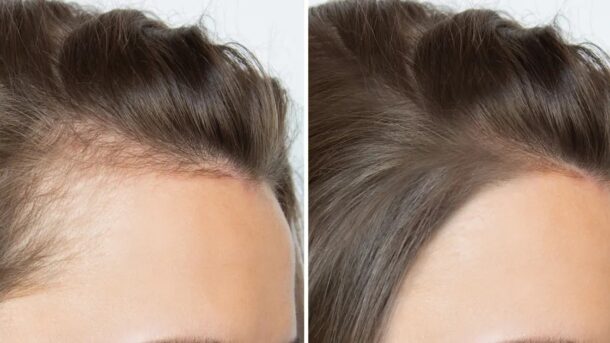
Understanding Hair Thinning & Shedding in Women
Medically termed Alopecia, this involves reduced scalp/body hair density, ranging from mild thinning to bald patches. Notably, two-thirds of postmenopausal women globally experience significant shedding or baldness. Identifying root causes is essential for effective solutions.
The 3 Stages of Hair Growth
- Anagen (Growth Phase): Follicles actively produce new strands, determining length.
- Catagen (Transition Phase): Growth slows; follicles shrink as strands enter rest.
- Telogen (Resting Phase): Strands remain until natural shedding occurs.
Prevalence in Females
Women of all ages experience reduced hair density. Crucially, up to 40% face this concern by age 50 or post-menopause, triggered by diverse factors.
Female-Pattern Baldness: What to Expect
Androgenetic Alopecia, the most common type, features diffuse thinning over the crown, potentially progressing to bald spots. Unlike male-pattern loss, women typically retain frontal hairlines. This gradual process often starts in the 20s but peaks midlife.
Key Triggers
- Genetics: Family history increases risk.
- Hormonal Shifts: Menopause, pregnancy, imbalances.
- Medical Conditions: PCOS, thyroid disorders, autoimmune diseases.
- Nutritional Deficiencies: Low iron, vitamin D, malnutrition.
- Stress/Trauma: Causes temporary Telogen Effluvium.
- Medical Therapies: Chemotherapy, radiation, harsh chemicals.
Common Types
- Androgenetic Alopecia: Thinning crown/hairline.
- Telogen Effluvium: Stress/illness-induced shedding.
- Alopecia Areata: Sudden autoimmune patchiness.
- Traction Alopecia: Hairstyle-induced follicle damage.
Advanced Treatment Solutions
Transformative, lasting approaches combining methods:
- Medications:
Minoxidil & Finasteride (topical/injected) stimulate growth and prevent further shedding. - PRP (Platelet-Rich Plasma):
Injected growth factors boost circulation and follicle activation (often with microneedling). - Mesotherapy:
Vitamin cocktails (Biotin, Panthenol, Pyridoxine HCl) nourish roots and reduce shedding. - Exosome Therapy (e.g., ASCE+ HRL):
Allogenic exosomes deliver 1000+ proteins/growth factors, mimicking stem cells to support regrowth. - Stem Cell Therapy:
Allogenic cells (optimal viability) stimulate follicles and promote density restoration. - Acell Regrowth Therapy:
FDA-approved ECM application regenerates follicles and improves scalp health. - FUE Hair Transplant:
Precision no-shave technique ensures natural-looking restoration. - Scalp Micropigmentation (SMP):
Creates the illusion of fuller density, camouflaging thinning areas/scars.
Benefits of Intervention
- Halts progression toward baldness.
- Restores natural density.
- Significantly boosts confidence through improved appearance.
Prevention Strategies
- Avoid damaging chemicals, tight hairstyles, and mechanical trauma.
- Seek early professional advice.
- Maintain nutrient-rich diets with targeted supplements.
- Use gentle products; minimize UV exposure.
Conclusion
Thinning hair is common but manageable. By understanding triggers, recognizing early signs, exploring advanced solutions, and adopting preventive care, women can effectively address shedding and enhance well-being. Consult a specialist for personalized plans.



